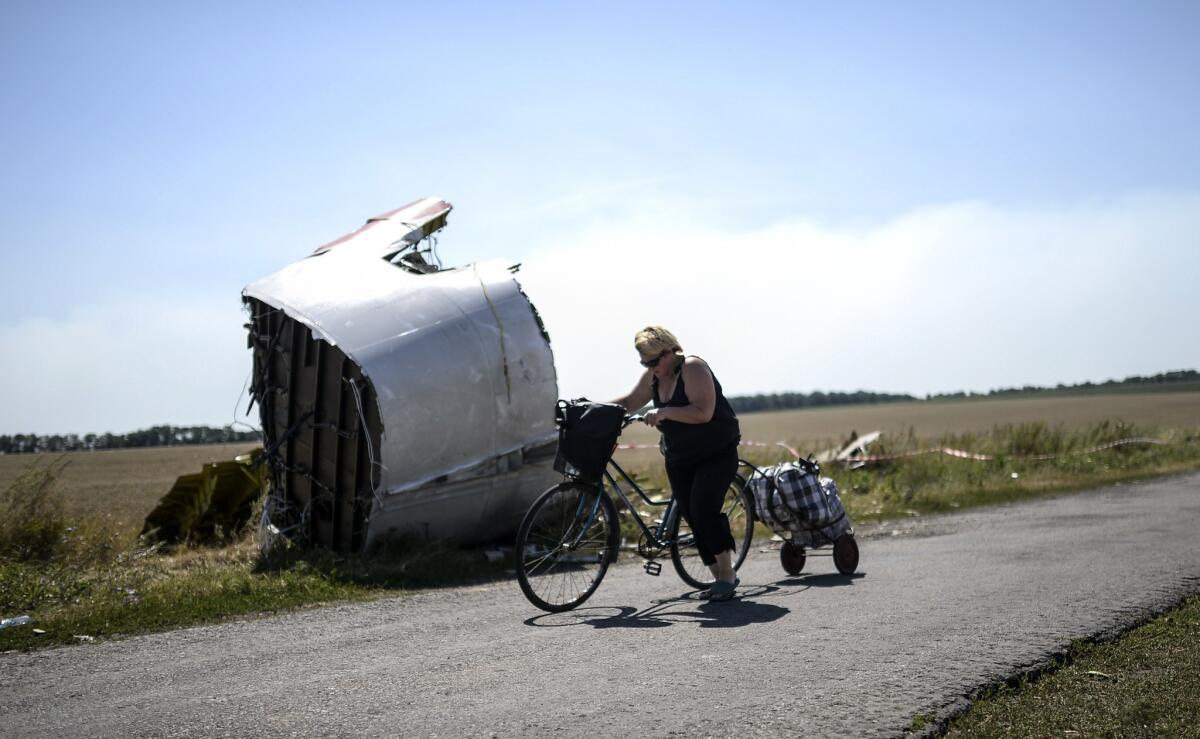Dutch report: Malaysia jet downed in Ukraine by ‘high-energy objects’

- Share via
A preliminary report on Malaysia Airlines Flight 17 appears to confirm initial assertions that the passenger plane was hit by a surface-to-air-missile in mid-flight July 17 before crashing in Ukraine.
“The pattern of damage observed on the forward fuselage and cockpit section of the aircraft appears to indicate that there were impacts from a large number of high-energy objects from outside the aircraft,” concluded a report issued Tuesday by the Netherlands’ air safety board.
The Boeing 777, en route from Amsterdam to Kuala Lumpur, the Malaysian capital, was flying at about 33,000 feet over separatist-held territory in southeastern Ukraine when it broke apart in midair and crashed, killing all 298 passengers and crew members on board.
The report says that fragments of the aircraft reveal numerous puncture holes and indentations on the plane’s skin that would be consistent with damage from missile shrapnel and, investigators say, rule out pilot error or any mechanical fault as the cause of the disaster.
Although investigators have not been able to recover these pieces for forensic examination, the report states that “the pattern of damage observed … was not consistent with the damage that would be expected from any known failure mode of the aircraft, its engines or systems.”
Working with experts from several other countries, including Malaysia, Russia and the United States, the Dutch team evaluated air-traffic control information along with photographs of the wreckage and data from the plane’s flight recorders.
Photographs and satellite images show debris spread out over an area of about three miles by six miles.
“The distribution of pieces of the aircraft over a large area indicates that the aircraft broke up in the air,” the report says. “Fuselage pieces, cargo and baggage were scattered through the wreckage site.”
Parts from the front of the plane were found closest to the plane’s last recorded position, indicating these were the first sections to break apart. The center and rear sections landed farther away. “This indicates that these parts continued in a down and forward trajectory before breaking up.”
The plane’s cockpit voice and flight data recorders, often referred to collectively as the “black boxes,” were not recovered by investigators but were removed from the wreckage by unknown individuals and turned over to a Malaysian official in the eastern Ukraine city of Donetsk several days after the crash.
Damage to the units was consistent with the nature of the crash, but their internal memory modules remained intact. They showed that communication from the crew gave no indication that anything had gone wrong with the flight. “No aircraft system warning or cautions were detected.” on the flight data recorder.
Both flight recorders end abruptly at 1:20 p.m., which matches the crew’s communication with air traffic control. Transcripts show the pilots checking in with controllers about 12 minutes before that time and then confirming coordinates seconds before communications ended.
“MALAYSIA one seven, due traffic proceed direct to point ROMEO NOVEMBER DELTA,” came the command from air traffic control.
The pilots confirmed: “ROMEO NOVEMBER DELTA, MALAYSIA one seven.”
Moments later, the aircraft was gone.
A Ukrainian air-traffic-control station checked Flight 17’s location with a controller in Russia.
“Do you observe the Malaysian by … by the response?” asked Ukrainian air traffic control.
“No, it seems that its target started falling apart,” replied the Russian controller.
“Yes it’s disappeared,” air traffic control in Ukraine later said.
“Yes, yes, yes, nothing. We see nothing,” Russian control later replied.
Air traffic control surveillance showed three other commercial aircraft in the same airspace about the same time as the incident that brought down Flight 17.
U.S. intelligence sources said shortly after the crash that the plane was destroyed by an SA-7 rocket fired by a Russian-made BUK launching system fired from separatist-held territory.
Russian President Vladimir Putin has denied accusations that his government supplied the sophisticated antiaircraft launcher to the separatists, who have seized much of Donetsk and Luhansk regions in a bid to retain Moscow’s influence in the predominantly Russian-speaking areas.
Gunmen blocked access to the crash site for two weeks and disturbed the debris field before the Dutch-led investigative team could begin its probe, the forensics experts told journalists in Kiev at the time. Fighting between the pro-Russia insurgents and Ukrainian government forces also delayed the investigation, which lasted less than a week before the Dutch government suspended it over security concerns.
A Dutch military forensics laboratory continues to work on identifying the remains collected by locals near the crash site, and the Dutch, Australian and Malaysian governments are proceeding with examination of evidence collected at the site during the few days they had access.
The Netherlands and Australia suffered the largest loss of life in the tragedy, with 196 and 38 citizens killed, respectively.
Dozens of the doomed passengers were researchers en route to an international AIDS conference in Australia, including prominent researcher Joep Lange, a former president of the International AIDS Society.
Investigators say their analysis is ongoing and a final report will be issued within a year’s time.
Special correspondent Werth reported from London and Times staff writer Williams from Los Angeles.
More to Read
Sign up for Essential California
The most important California stories and recommendations in your inbox every morning.
You may occasionally receive promotional content from the Los Angeles Times.











